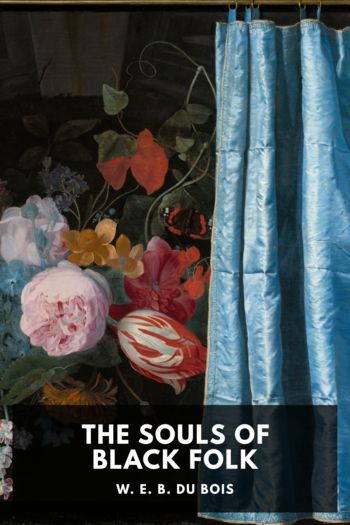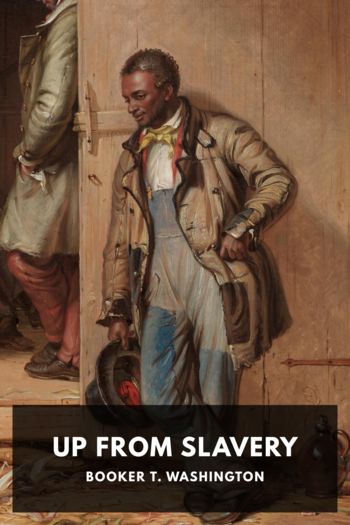The Souls of Black Folk, W. E. B. Du Bois [color ebook reader TXT] 📗

- Author: W. E. B. Du Bois
Book online «The Souls of Black Folk, W. E. B. Du Bois [color ebook reader TXT] 📗». Author W. E. B. Du Bois
Such, then, is the large development of the Negro church since Emancipation. The question now is, What have been the successive steps of this social history and what are the present tendencies? First, we must realize that no such institution as the Negro church could rear itself without definite historical foundations. These foundations we can find if we remember that the social history of the Negro did not start in America. He was brought from a definite social environment—the polygamous clan life under the headship of the chief and the potent influence of the priest. His religion was nature-worship, with profound belief in invisible surrounding influences, good and bad, and his worship was through incantation and sacrifice. The first rude change in this life was the slave ship and the West Indian sugar-fields. The plantation organization replaced the clan and tribe, and the white master replaced the chief with far greater and more despotic powers. Forced and long-continued toil became the rule of life, the old ties of blood relationship and kinship disappeared, and instead of the family appeared a new polygamy and polyandry, which, in some cases, almost reached promiscuity. It was a terrific social revolution, and yet some traces were retained of the former group life, and the chief remaining institution was the Priest or Medicine-man. He early appeared on the plantation and found his function as the healer of the sick, the interpreter of the Unknown, the comforter of the sorrowing, the supernatural avenger of wrong, and the one who rudely but picturesquely expressed the longing, disappointment, and resentment of a stolen and oppressed people. Thus, as bard, physician, judge, and priest, within the narrow limits allowed by the slave system, rose the Negro preacher, and under him the first church was not at first by any means Christian nor definitely organized; rather it was an adaptation and mingling of heathen rites among the members of each plantation, and roughly designated as Voodooism. Association with the masters, missionary effort and motives of expediency gave these rites an early veneer of Christianity, and after the lapse of many generations the Negro church became Christian.
Two characteristic things must be noticed in regard to the church. First, it became almost entirely Baptist and Methodist in faith; secondly, as a social institution it antedated by many decades the monogamic Negro home. From the very circumstances of its beginning, the church was confined to the plantation, and consisted primarily of a series of disconnected units; although, later on, some freedom of movement was allowed, still this geographical limitation was always important and was one cause of the spread of the decentralized and democratic Baptist faith among the slaves. At the same time, the visible rite of baptism appealed strongly to their mystic temperament. Today the Baptist Church is still largest in membership among Negroes, and has a million and a half communicants. Next in popularity came the churches organized in connection with the white neighboring churches, chiefly Baptist and Methodist, with a few Episcopalian and others. The Methodists still form the second greatest denomination, with nearly a million members. The faith of these two leading denominations was more suited to the slave church from the prominence they gave to religious feeling and fervor. The Negro membership in other denominations has always been small and relatively unimportant, although the Episcopalians and Presbyterians are gaining among the more intelligent classes today, and the Catholic Church is making headway in certain sections. After Emancipation, and still earlier in the North, the Negro churches largely severed such affiliations as they had had with the white churches, either by choice or by compulsion. The Baptist churches became independent, but the Methodists were compelled early to unite for purposes of episcopal government. This gave rise to the great African Methodist Church, the greatest Negro organization in the world, to the Zion Church and the Colored Methodist, and to the black conferences and churches in this and other denominations.
The second fact noted, namely, that the Negro church antedates the Negro home, leads to an explanation of much that is paradoxical in this communistic institution and in the morals of its members. But especially it leads us to regard this institution as peculiarly the expression of the inner ethical life of a people in a sense seldom true elsewhere. Let us turn, then, from the outer physical development of the church to the more important inner ethical life of the people who compose it. The Negro has already been pointed out many times as a religious animal—a being of that deep emotional nature which turns instinctively toward the supernatural. Endowed with a rich tropical imagination and a keen, delicate appreciation of Nature, the transplanted African lived in a world animate with gods and devils, elves and witches; full of strange influences—of Good to be implored, of Evil to be propitiated. Slavery, then, was to him the dark triumph of Evil over him. All the hateful powers of the Underworld were striving against him, and a spirit of revolt and revenge filled his heart. He called up all the resources of heathenism to aid—exorcism and witchcraft, the mysterious Obi worship with its barbarious rites, spells, and blood-sacrifice even, now and then, of human victims. Weird midnight orgies and mystic conjurations were invoked, the witch-woman and the voodoo-priest became the centre of Negro group life, and that vein of vague superstition which characterizes the unlettered Negro even today was deepened and strengthened.
In spite, however, of such success as that of the fierce Maroons, the Danish blacks, and others, the spirit of revolt gradually died away under the untiring energy and superior strength of the slave masters. By the middle of the eighteenth century the black slave had sunk,





Comments (0)